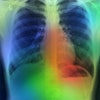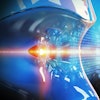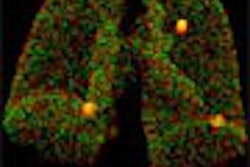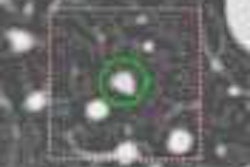VIENNA - Version 5.0 of the CADx breast computer-aided detection software offers only a slight improvement in sensitivity over the previous version, 3.5, but reduces false-positives significantly, according Dr. Ansgar Malich from Friedrich-Schiller University in Jena, Germany.
Malich and colleagues decided to test the system when the latest upgrade was delivered to their clinic. "Every year we get a new software version," he said Tuesday at the European Congress of Radiology. "The question is: Is it a real benefit to us or just a money-making venture?"
The group evaluated 355 mammography cases retrospectively, including 200 patients without any finding or suspicion of malignancy (BI-RADS 1), 125 patients having 132 small malignancies (including two BIRADS 3, 71 BI-RADS 4, 50 BI-RADS 5), as well as 30 cases of benign breast masses (all BI-RADS 4).
"We did not perform any preselection of size and location, (however), we included only cases with one lesion, and that means we had contralateral findings in the malignant group," Malich said. "Then we had CADx Second Look (comparing) software versions 3.5 with 5.0. The system marks suspected lesions by ellipses, (and) by rectangles for microcalcifications. There is no (lesion) size limit in this CAD system, and it takes about five minutes to scan a case."
The overall cancer detection rate was 90.2% (119/132), a slight improvement from version 3.5 at 88.6% (117/132).
"But, and this is the main message of the new software version, the false-positive rate is significantly decreased, from 0.74% to 0.28% in the group (n=125) containing the (n=132) malignancies, with similar decreases in false-positives in the benign histologically proven group as well as the screening group (of 200 patients)," Malich said.
The 90.2% overall detection rate included both malignant BI-RADS 3 lesions, which were correctly detected (100%), 59/71 (83.1%) BI-RADS 4 lesions, and 58/59 (98.3%) BI-RADS 5 lesions. The benign findings were marked correctly in 9/30 cases (30%). The false-positive rate for the new version broke down as follows: 0.28% for malignancies, 0.88% benign cases, and 0.41% for screening cases.
The false-positive rate for version 3.5 was 74% for malignancies, 1.45% for benign cases, and 0.94% for screening cases. Thus the corresponding reduction in false-positives was 62.2%, 39.3%, and 56.4% in the new version.
Specificity remained a problem, however. "Out of the 30 histologically verified benign cases, only nine had correctly no mark at all, and regarding the (200) screening cases...only 100 were correctly not marked at all, so this means there is a specificity rate of 50%."
CAD systems are being debated vigorously in Europe, he said, particularly due to a few limitations that need to be addressed. For one thing, the detection rate is not perfect. For another, CAD systems are very expensive, and still produce very high false-positive rates.
"There are some studies -- controversial -- discussing the increased rate of recall patients, and further recommended procedures when using CAD systems," he said. Finally, there has been a lack of increased tumor detection by inexperienced radiologists using CAD, as well as other issues.
Yet there are positive aspects of CAD too, notably its ability to compensate for the severe shortage of radiologists in Germany, he said. CAD can often take the place of a second reader who is, in fact, not available. Using CAD as a second reader may reduce overall costs even when taking into account the high cost of the systems, he said.
"The detection rate is promising, and still increasing, using the new software version, and the specificity for suspicious lesions is encouraging," Malich concluded. "Furthermore, an advantage is that we have a significant decrease in the false-positive rate, but the false-positive rate even in the new version is too high to be used as a primary diagnostic tool, and the specificity in screening cases is much too low, and has to be increased in further developments."
By Eric BarnesAuntMinnie.com staff writer
March 10, 2004
Related Reading
Computer analysis does not improve mammographic detection of breast cancer, February 4, 2004
Probability calculator identifies cancers dismissed by mammographers, January 29, 2004
Foundations laid, CAD technology builds mainstream support, January 13, 2003
Copyright © 2004 AuntMinnie.com



















